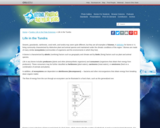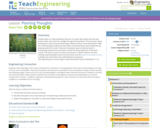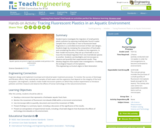
This resource provides information about ecology.
- Subject:
- Science
- Material Type:
- Lesson
- Provider:
- National Center for Ecological Analysis and Synthesis, University of California Santa Barbara
- Date Added:
- 08/07/2023

This resource provides information about ecology.

The Web of Life is a story told by a common garden spider at this site from Kids' Planet. Learn about the food web, and the roles and relationships of every living creature.

Learn how energy is passed along through living things in a food chain and web.
A free CK-12 account is required to view all materials.

Learn how energy is transferred along a food chain.
A free CK-12 account is required to view all materials.

Producers make their own food through photosynthesis. But many organisms are not producers and cannot make their own food, but must get their energy from other organisms. These organisms are called consumers. Decomposers get nutrients and energy by breaking down dead organisms and animal wastes. Learn more about consumers and decomposers in this learning module produced by CK-12.
A free CK-12 account is required to view all materials.

When an herbivore eats a plant, the energy in the plant tissues is used by the herbivore. Every time energy is transferred from one organism to another, there is a loss of energy. This loss of energy can be shown in an energy pyramid. Learn more about the flow of energy in an ecosystem in this learning module produced by CK-12.
A free CK-12 account is required to view all materials.

This article discuss basic ecological concepts such as food chains and webs within the context of the tundra.

This animation discusses the food chain in a storybook format. The chain is described as a cycle and both herbivores and carnivores are discussed.

This concise site that provides an explanation of what producers are along with a short quiz to test your knowledge of producers and consumers.

Detailed website that was a companion to a 1995 traveling exhibit of the Smithsonian. Links to lesson plans and other educational materials are at the bottom of the page. Enter the exhibition to explore the world of the ocean.

Students gain an understanding of the parts of a plant, plant types and how they produce their own food from sunlight through photosynthesis. They also learn about transpiration, the process by which plants release moisture to the atmosphere. With this understanding, students test the effects of photosynthesis and transpiration by growing a plant from seed. They learn how plants play an important part in maintaining a balanced environment in which the living organisms of the Earth survive. This lesson is part of a series of six lessons in which students use their evolving understanding of various environments and the engineering design process, to design and create their own model biodome ecosystems.

This lesson explains the role plants play in the conversion of inorganic materials into organic material to support living things. It is 2 of 3 in the series titled "The Role of Plants in the Food Chain."

Echolocation is the ability to orient by transmitting sound and receiving echoes from objects in the environment. As a result of a Marco-Polo type activity and subsequent lesson, students learn basic concepts of echolocation. They use these concepts to understand how dolphins use echolocation to locate prey, escape predators, navigate their environment, such as avoiding gillnets set by commercial fishing vessels. Students will also learn that dolphin sounds are vibrations created by vocal organs, and that sound is a type of wave or signal that carries energy and information especially in the dolphin's case. Students will learn that a dolphin's sense of hearing is highly enhanced and better than that of human hearing. Students will also be introduced to the concept of by-catch Students will learn what happens to animals caught through by-catch and why.

Student teams investigate the migration of small-particle plastic pollution by exposing invertebrates found in water samples from a local lake or river to fluorescent bead fragments in a controlled environment of their own designs. Students begin by reviewing the composition of food webs and considering the ethics of studies on live organisms. In their model microcosms, they set up a food web so as to trace the microbead migration from one invertebrate species to another. Students use blacklights and microscopes to observe and quantify their experimental results. They develop diagrams that explain their investigations—modeling the ecological impacts of microplastics.

This nonfiction article, written for students in grades 4-5, explores blue whales, their food chain, and their home in the Southern Ocean. Modified versions are available for students in younger grades.

Work samples, phenomena, assessment templates, and videos that directly address standard 5-PS3-1: food energy from the sun.